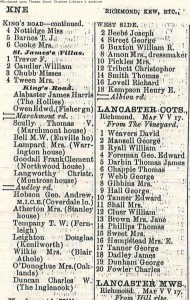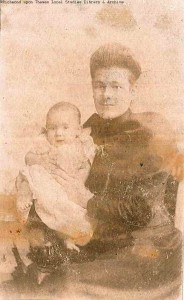Timeless and enduring: the Dora Lewis letters
Patricia Moloney, Heritage Assistant, reflects on and describes the experience of cataloguing this fascinating collection of letters for Richmond upon Thames Local Studies Library & Archive.
Background
The latest archival collection to be catalogued is, at first glance, a modest sequence of 15 letters and a photograph contained in a slim A4 folder. Yet the life-story it depicts proves powerful and thought provoking. The process of cataloguing this collection offered opportunities to gain an insight into life in the borough at the turn of the 19th century for a young woman from Gateshead, Dora Lewis, who met and fell in love with a Richmond resident, Charles Tween (whom she affectionately refers to as ‘chum’ throughout the early letters). It proved to be a relationship that transformed her life.
Context
Dora was born in Gilling, near Richmond, Yorkshire in 1874. By 1891, most of the family had moved to Gateshead, County Durham. An elder sister, Hannah, had married a tea merchant, Grant Scott and was living in Bloomsbury, central London. They may have later moved to Richmond (Surrey). Dora was also known as ‘Dolly’.
Charles Frederick Tween was born in Ware in Hertfordshire around 1860. He had moved to Paddington by 1871 and then to Richmond (Surrey) by 1881. According to the 1891 census he was a Corn Factor, still single and living in St James Villas, Kings Road, Richmond with his mother, brother, and 2 servants. (The extract from Kelly’s Directory of Richmond 1897 – 98 shows the family dwelling there, listed in his mother’s name, Mrs Tween).  In 1896, Dora became pregnant by Charles. She returned to Gateshead where their baby was born in early 1897 and named Marion. However, in late 1898 she was living in Liverpool where she married an engineer called Talbot Cheesman. She did not mention this to Charles and continued to use her maiden name throughout the correspondence. By September 1900 she was living in Putney with her husband and Marion. Dora and Talbot both died in 1939, in Chelsea and Hammersmith respectively. The fate of Marion is not known. Charles Tween married Mary Harrison in September 1904 in Richmond.
In 1896, Dora became pregnant by Charles. She returned to Gateshead where their baby was born in early 1897 and named Marion. However, in late 1898 she was living in Liverpool where she married an engineer called Talbot Cheesman. She did not mention this to Charles and continued to use her maiden name throughout the correspondence. By September 1900 she was living in Putney with her husband and Marion. Dora and Talbot both died in 1939, in Chelsea and Hammersmith respectively. The fate of Marion is not known. Charles Tween married Mary Harrison in September 1904 in Richmond.
The collection
The collection of letter itself comprises 12 letters from Dora to Charles and a photograph; 2 letters from Dora’s solicitor Mr W. H. Matthews to Charles and finally 1 letter from Dora’s sister Alice to Charles. Dora’s voice carries down through the years, telling a very human story without restraint. Life was (as it is now) complicated, and a social history emerges with Richmond as the backdrop. An intense snapshot of her experiences as part of the local community from 1897 – 1901 provides a framework for themes such as the class system, the importance of the family, the situation for women at that time, poverty, healthcare and education. Dora does not hide her emotions and we learn a lot about her personality and character.
Now that the collection is catalogued it is accessible by searching for DC15 the Dora Lewis Letters on our online catalogue (click here) or by visiting the search room at Richmond upon Thames Local Studies Library & Archive to experience the archive material first hand. Viewing the original letters offers an exciting extra perspective. Through their condition, the language and the style of writing we can reflect on Dora’s feelings, thoughts, sufferings and fears.
The impact of an image from the past
The photograph also teaches us about Dora’s character. It does not conform to the traditional Victorian family photo. We see a composed young woman proudly displaying her energetic little girl but what is missing in terms of the social norms of the day is the bread-winner/man of the house. We know that she has paid for the photograph with her own hard-won income (cf DC15/1/8). Dora is uncompromising in her struggle to provide the best opportunities for Marion and is not ashamed of her daughter even though at that time the expectation was that a young woman would be married. There were limited opportunities otherwise. Dora is a survivor and moves from being profoundly in love with Charles to the legal realities of pursuing him via the law for financial support to enable their daughter to go to school. She had some family support, strove to remain employed and eventually successfully married. She may have been living hand to mouth but Dora did not end up on the streets or in the workhouse.
A mystery
This collection also represents a mystery: there is a missing voice, that of Charles. Though absent in the correspondence and in the lives of Dora and Marion he is ever-present in the reader’s mind. It is only possible to speculate on how the letters have survived as a collection. It is not possible to definitively say whether Charles hung on to them (despite his later marriage) due to his feelings for Dora, out of necessity or out of guilt about the daughter he never really acknowledged. This remains a mystery. These letters remain for me a powerful, poignant and sad true-life story that has resonance even today.
[ Patricia Moloney, Heritage Assistant ]

